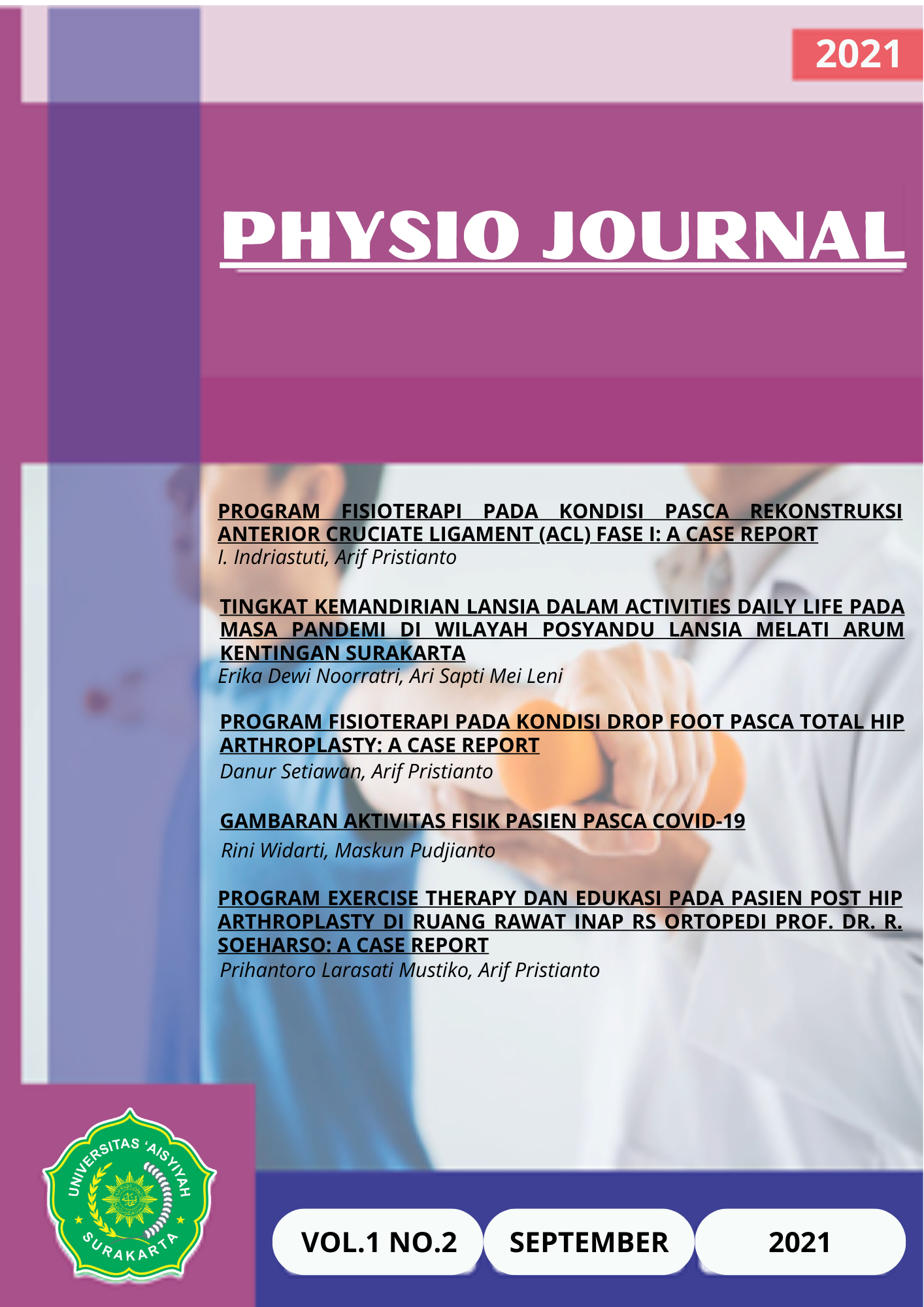Gambaran Aktivitas Fisik Pasien Pasca Covid-19
DOI:
https://doi.org/10.30787/phyjou.v1i2.798Keywords:
covid-19, aktivitas fisik, pandemiAbstract
Pasien yang sudah dinyatakan sembuh tentunya juga harus memperhatikan aktivitas fisiknya antara sebelum terkena penyakit Covid-19 dan sesudah sembuh dari penyakit tersebut. Kurangnya melakukan aktivitas fisik dapat berpengaruh pada kekebalan tubuh karena pada dasarnya saat tubuh tidak di paksa melakukan aktifitas fisik maka imunitas tubuh juga bisa menurun dan mudah terserang penyakit/virus namun dengan memperhatikan intensitas dari latihan fisik yang akan di lakukan. Tujuan dari penelitian ini adalah untuk mengetahui gambaran aktivitas fisik pasien pasca Covid-19. Jenis penelitian menggunakan deskriptif kualitatif dan dengan desain penelitian observasional dalam bentuk survei. Penelitian dilaksanakan pada bulan Maret-April 2021 di Kota Surakarta. Yang menjadi informan sebanyak 7 orang responden. Instrumen penelitian yaitu International Physical Activity Questionnaire (IPAQ). Hasil penelitian berdasarkan kuesioner aktivitas fisik didapatkan bahwa sebagain besar responden memiliki tingkat aktivitas fisik kategori sedang dengan jumlah 6 orang (85,7%), sedangkan aktivitas fisik kategori tinggi dengan jumlah 1 orang (14,3%). Peneliti melihat seluruh responden melakukan minimal 150 menit perminggu dalam melakukan aktivitas fisik moderat sesuai dengan yang di rekomendasikan.
References
Barcellos, F. C., Santos, I. S., Umpierre, D., Bohlke, M., & Hallal, P. C. (2015). Effects of exercise in the whole spectrum of chronic kidney disease : a systematic review. Clinical Kidney Journal, 8(6), 753–765.
Callow, M. A., Callow, D. D., & Smith, C. (2020). Older Adults ’ Intention to Socially Isolate Once COVID-19 Stay-at-Home Orders Are Replaced With “ Safer-at-Home †Public Health Advisories : A Survey of Respondents in Maryland. Journal of Applied Gerontology, 1–9.
Ceraolo, C., & Giorgi, F. M. (2020). Genomic variance of the 2019 †nCoV coronavirus. Journal of Medical Virology Wiley, 92, 522–528.
Chan, J. F., Yuan, S., Kok, K., To, K. K., Chu, H., Yang, J., Xing, F., Liu, J., Yip, C. C., Poon, R. W., Tsoi, H., Lo, S. K., Chan, K., Poon, V. K., Chan, W., & Ip, J. D. (2020). Articles A familial cluster of pneumonia associated with the 2019 novel coronavirus indicating person-toperson transmission : a study of a family cluster. The Lancet, 6736(20), 1–10.
Gloeckl, R., Schneeberger, T., Jarosch, I.,
& Kenn, K. (2018). Pulmonary
Rehabilitation and Exercise Train- ing in Chronic Obstructive Pulmonary Disease. Medicine, 115, 117–124.
Halle, M., & Heitkamp, M. (2021).
Prevention of cardiovascular disease : does ‘ every step counts ’ apply for occupational work ? European Heart Journal, 42, 1512–1515.
Healey, J. (2013). Physical Activity and Fitness (361st ed.). The Spinney Press.
Huang, C., Wang, Y., Li, X., Ren, L., Zhao, J., Hu, Y., Zhang, L., Fan, G., Xu, J., & Gu, X. (2020). Articles Clinical features of patients infected with 2019 novel coronavirus in Wuhan , China. The Lancet, 6736(20), 1–10.
Kesehatan, K. (2017). Panduan Pelaksanaan Gerakan Nusantara Tekan Angka Obesitas (GENTAS) (pp. 1–41). Kementerian Kesehatan
Republik Indonesia.
Kirkman, D. L., Scott, M., Kidd, J., & Macdonald, J. H. (2019). The Effects of Intradialytic Exercise on Hemodialysis Adequacy : A systematic review. In Seminars in Dialysis.
Lei, J., Li, J., Li, Z., & Qi, X. (2020). CT Imaging of the 2019 Novel Coronavirus (2019-nCoV) Pneumonia. In Radiology.
Liu, T., Zhang, J., Yang, Y., Ma, H., Li, Z., Zhang, J., Cheng, J., Zhang, X., Zhao, Y., Xia, Z., Zhang, L., Wu, G., & Yi, J. (2020). The role of interleukin- 6 in monitoring severe case of coronavirus disease 2019. EMBO Molecular
Medicine, 12, 1–12.
Martin, S. A., Pence, B. D., & Woods, J. A. (2009). Exercise and Respiratory Tract Viral Infections. Exerc Sport Sci Rev, 37(4), 157–164.
Nurhadi, J. Z. L., & Fatahillah. (2020). Pengaruh Pandemi Covid-19 Terhadap Tingkat Aktivitas Fisik pada Masyarakat Komplek Pratama, Kelurahan Medan Tembung. Jurnal Health Sains, 1(5), 294–298.
Nurmasitoh, T. (2015). Physical activities, exercises, and their effects to the immune system. Jurnal Kedokteran Dan Kesehatan Indonesia, 7(2), 52– 58.
Olson, M. (2014). It’s a HIIT. ACSM’s HEALTH & FITNESS JOURNAL,
(5), 17–24.
Prastyowati, A. (2020). Mengenal Karakteristik Virus SARS-CoV-2 Penyebab Penyakit COVID-19 Sebagai Dasar Upaya Untuk Pengembangan Obat Antivirus Dan Vaksin. BioTrends, 11(1), 1–10.
Ravalli, S., & Musumeci, G. (2020). Coronavirus Outbreak in Italy :
Physiological Benefits of HomeBased Exercise During Pandemic. Journal of Functional Morphology and Kinesiology, 5(31), 1–6.
Schindler, M. J., Adams, V., & Halle, M. (2019). Exercise in Heart Failure — What Is the Optimal Dose to Improve Pathophysiology and Exercise
Capacity ? Current Heart Failure Reports, 16, 98–107.
Utami, L. S. S. (2015). Teori-Teori Adaptasi Antar Budaya. Jurnal Komunikasi, 7(2), 180–197.
WHO. (2018). Global Tuberculosis Report 2018. World Health Organization.
WHO. (2020). China Joint Mission on Coronavirus Disease 2019 ( COVID-
).
Zhang, Y., & Ma, Z. F. (2020). Impact of the COVID-19 Pandemic on Mental Health and Quality of Life among Local Residents in Liaoning Province
, China : A Cross-Sectional Study.
International Journal of Environmental Research and Public Health, 17(2381), 1–12.
Zhu, N., Zhang, D., Wang, W., Li, X., Yang, B., Song, J., Zhao, X., Huang, B., Shi, W., Lu, R., Niu, P., Zhan, F., Ma, X., Wang, D., Xu, W., Wu, G., Gao, G. F., Phil, D., & Tan, W. (2020). A Novel Coronavirus from
Downloads
Published
Issue
Section
License

This work is licensed under a Creative Commons Attribution-ShareAlike 4.0 International License.









